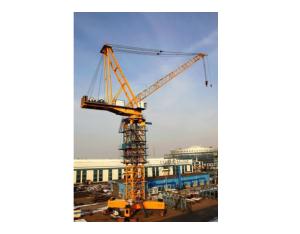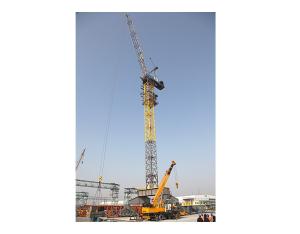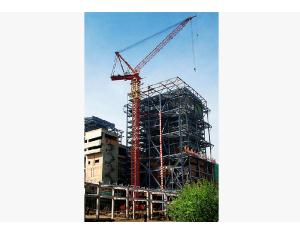Tower Crane-FZQ2520
- Product Details
- Company Profile
FZQ2520 attached self-climbing tower crane is an upgrade of “FZQ attached self-climbing tower crane series” and the biggest luffing jib tower crane in China series of products is a new type of tower cranes containing the most technological content and the most advanced performances in China at present. They have used advanced imported mechanism in the world and high strength materials, and a few pieces of technology adopted has filled domestic blanks. Their comprehensive performance is advanced globally. Adopting trolley travelling mechanism on luffing jibs, upper slewing, upper climbing, postposition of boom hinge point and attached tower body, FZQ attached self-climbing tower crane series is characterized by big lifting height, big lifting capacity, wide range of operation, great wind resistance, light dead weight, flexible layout, easy installation and dismantlement and low costs for site transformation, installation and dismantlement. self-climbing tower crane series products are applicable to the installation of thermal power stations, hydro power stations and nuclear power stations, petroleum, chemical, and metallurgical industries, high-rise steel structure and other large construction projects, particularly in the construction of tower boiler power stations and other cases where the construction site is so narrow that other types of cranes can not work. The tower body of FZQ2520 attached self-climbing tower crane is composed of foundation section, standard mast section and attached section, which have the same section size. The tower body is a modular dismantling composite of tube truss structure. The main chord has a big section, the tower body has a small section, and the web members are K-shaped. The main chords in the tower body are standard components which are connected with taper pins. The tower’s standard section and attached section can be interchanged during installation as required by site conditions. The sections of the tower body are join
| Rated hoisting moment kNm | 25200 | Working grade(GB/T 3811-2008) | A4 | ||||||||
| Rated hoisting capacity | Main hook | Jib length44.7m | Jib length55.2m | Jib length65.7m | hoisting speedm/min | Main | Jib44.7m | Jib55.2m | Jib65.7m | ||
| 150 | 112 | 100 | 0~5.2 | 0~7.8 | 0~7.8 | ||||||
| When the main hook is working at maximum radius | Jib length44.7m | Jib length55.2m | Jib length65.7m |
| Main | Jib44.7m | Jib55.2m | Jib65.7m | |||
| 50 | 38 | 23 | 0~10.4 | 0~15.6 | 0~15.6 | ||||||
| When the main hook is in a special conditionM | 30 | Auxiliary | 0~21.3 | ||||||||
| Auxiliary hookM | 18 | Auxiliary hoisting(light load≤7t) | 0~42.6 | ||||||||
| Operating radius | Main hook | Jib length44.7m | Jib length55.2m | Jib length65.7m | The time trolley takes to travel the whole range | 12.7 | |||||
| 7~40 | 7~50 | 8.9~60 | |||||||||
| When the main hook works in a special condition | 7~10 | 7~10 | 8.9~10 | Rotation speed | 0~0.25 | ||||||
| when the rated hoisting capacity of main hook is 112t | 10~16.5 | 10~22.5 | 10~23 | Slewing angle | Complete slewing | ||||||
| Auxiliary hook A | 8.9~44 | 8.7~54 | 10.76~64 | Slewing radius of the tail end of chassis station m | 17.16 | ||||||
| Hoisting heightm | Main hook | Jib length44.7m | Jib length55.2m | Jib length65.7m | Hydraulic climbing speed m/min | 0.35 | |||||
| 141 | 151 | 162 | |||||||||
| Auxiliary hook | Jib length44.7m | Jib length55.2m | Jib length65.7m | Each climbing range m | 1.675~1.676 | ||||||
| 145 | 155 | 166 | |||||||||
| Max height of hinge point on jib frame m | 107 | Total power* kW | 400 | ||||||||
| Operating conditions* | |||||||||||
| power: three-phase five-wire system 380V 50Hz | |||||||||||
| Calculate wind pressure(N/m2) | Working state | 250 | Allowable ambient temperature(℃) | Minimum when working | -20 | ||||||
| Off-working state | 1300 | Minimum at working area | -40 | ||||||||
| When installing climbing mechanism | 100 | When using electrical equipment | +0~+40 | ||||||||
| Allowable working humidity | 1-80% | Allowable working altitude | No higher than 2000m (motor capacity should be checked when the altitude is higher than 1000m) | ||||||||
| Execution standard:GB/T 3811-2008《Specifications for Crane Design》、 GB/T 13752-92《Specifications for Tower Crane Design》 GB 6067-2006《Safety Code for Cranes 》、 JB 4315《Electric Control Device of Cranes》 GB 5144-2006《Safety Code for Tower Cranes》 | |||||||||||












 CCCME Member
CCCME Member 0
0 Chinese
Supplier
Chinese
Supplier
